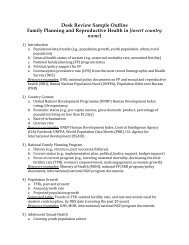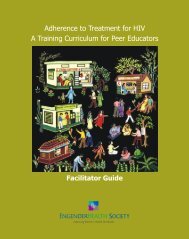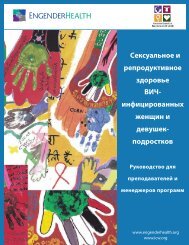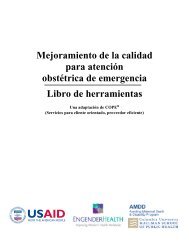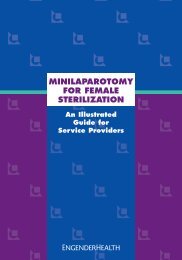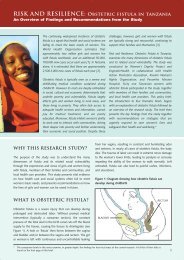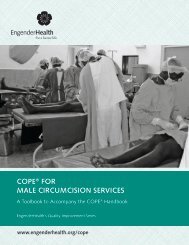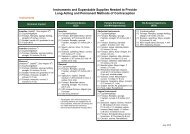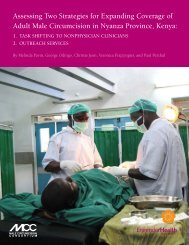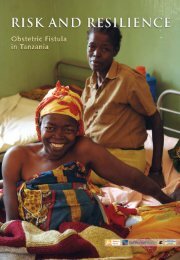Help-Seeking Pathways and Barriers for ... - EngenderHealth
Help-Seeking Pathways and Barriers for ... - EngenderHealth
Help-Seeking Pathways and Barriers for ... - EngenderHealth
Create successful ePaper yourself
Turn your PDF publications into a flip-book with our unique Google optimized e-Paper software.
B. Existing Services <strong>and</strong> Sources of Support<br />
This section describes the profile of GBV services <strong>and</strong> types of support that emerged from<br />
the key in<strong>for</strong>mant interviews in Dar es Salaam, Iringa, <strong>and</strong> Mbeya. As described in the<br />
methodology, the research team interviewed service providers from civil society, health,<br />
legal <strong>and</strong> justice, <strong>and</strong> government sectors, as well as “in<strong>for</strong>mal” resource persons such as<br />
respected community elders <strong>and</strong> local leaders. 16 While there is considerable variation in the<br />
services available across locations, the analysis below outlines the package of expected<br />
support <strong>for</strong> each provider type. Subsequently, in Sections C <strong>and</strong> D, the paper will discuss<br />
the socio-cultural <strong>and</strong> structural barriers to help-seeking as well as adequate service<br />
provision.<br />
1. Family <strong>and</strong> Social Networks<br />
Key in<strong>for</strong>mants consistently described the family as the first source of help-seeking <strong>for</strong><br />
survivors of GBV. The family’s role is to offer advice, emotional support, <strong>and</strong>, in the case of<br />
domestic violence, help mediate between the woman <strong>and</strong> her husb<strong>and</strong>. In general, married<br />
women are expected to first speak with their husb<strong>and</strong>’s family members be<strong>for</strong>e reporting<br />
violence to the police. A frequent pathway reported by both service providers <strong>and</strong><br />
community members begins with the marital family (often fathers, mothers, <strong>and</strong> brothersin-law).<br />
If the issue remains unresolved, a survivor may then consult members of her natal<br />
family, <strong>and</strong>, subsequently, a family meeting can be arranged between both families. Other<br />
members of one’s social network—<strong>for</strong> example friends, neighbors, <strong>and</strong> respected elders—<br />
can participate in these meetings, acting as mediators <strong>and</strong> providing advice. While the<br />
structure <strong>and</strong> mechanisms of a family meeting differ by community, ultimately the goal is to<br />
find a solution <strong>and</strong> reconcile the marriage. Only when a problem cannot be solved within the<br />
family or immediate social network is it socially acceptable to approach external sources of<br />
support. For example, the following quotation illustrates the centrality of the family in<br />
addressing GBV.<br />
She [a GBV survivor] was told to keep quiet because it will bring shame, <strong>and</strong> going to<br />
the police will humiliate their son. I intervened as a social worker but they [her in-laws]<br />
wanted to deal with it within the family, then I had to let go.<br />
Duty Bearer, Mbeya<br />
For unmarried women who experience intimate partner violence their source of help was not<br />
so much the family but rather, friends since their relationship was considered “not <strong>for</strong>mal.”<br />
In cases of stranger violence the role of the family is primarily concerned with emotional<br />
support (rather than reconciliation) <strong>and</strong> linking the survivor to <strong>for</strong>mal help-seeking<br />
channels.<br />
16 While precise definitions of “<strong>for</strong>mal” versus “in<strong>for</strong>mal” providers varied across in<strong>for</strong>mants, overall unpaid<br />
individuals or volunteers who do not work out of an office were most often described as in<strong>for</strong>mal, <strong>for</strong><br />
example elderly members of the community considered to be “wise” <strong>and</strong> “respected.”<br />
<strong>Help</strong>-<strong>Seeking</strong> <strong>Pathways</strong> <strong>and</strong> <strong>Barriers</strong> <strong>for</strong> Survivors of GBV in Tanzania March 2013<br />
Page 25




